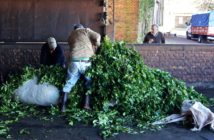Enjoying your first cup of the day right now? Delicious, right? But just where did that tea come from? Take our short quiz to see if you know!
Which of these places exports the most tea?
- Sri Lanka
- China
- Kenya
- Vietnam
- India
ANSWER: Kenya is the tea capital of the world! (admit it, you guessed “all-the-tea-in” China!)
Kenya is the world’s top exporter of tea by weight—it earned the title in both 2010 and 2012, according to the USDA’s GAIN (Global Agricultural Information Network) Report. Tea exports earn the country the most foreign dollars, even outranking both tourism and horticulture.
A great deal of the country’s population benefits from tea production. Tea cultivation and manufacturing is present in 15 of Kenya’s 47 counties and impacts a large proportion of Kenya’s 44 million people. Tea provides income and employment to 600,000 smallholder households and 150,000 workers at tea estates.
Which country imports the most tea?
- United Kingdom
- Russian Federation
- United States
- United Arab Emirates
- Pakistan
ANSWER: Your first guess might have been the UK—but it’s the Russian Federation that leads in tea enjoyment. The U.S. is the world’s third largest tea importer—and tea consumption in the States has been increasing since at least 2005!
Did You Know?
- Like most black tea, Kenyan tea is produced from the Camellia sinensis var. assamica plant, native to the Assam region of India.
- How do you decide if a tea is good enough to export? Tea specialists perform the ultimate taste test! In a process called infusion, hot water is mixed with loose tea. The result is referred to as liquor, and it is drunk with hard, quick slurps to ensure that the tea spreads throughout the mouth. It’s a noisy process, and a spittoon is kept handy. Judging the tea’s quality isn’t just about taste, though. Experts also consider the appearance of the dry tea, the wet residue, and the look of the liquor as it is mixed with milk to provide visual contrast.
- Kenyan tea is mostly grown at elevations between 1,700 and 1,800 meters, and sometimes as low as 1,500 meters. Tea plants last about 70 years and are pruned to their trunks every 3 years.
- Crush, Tear, Curl. This is the most common means of breaking down tea leaves for black tea. A series of rollers crush, tear, and curl the leaves, resulting in small pieces. Most specialty teas don’t use this method, preferring the more delicate and nuanced flavors that come from whole-leaf tea.


